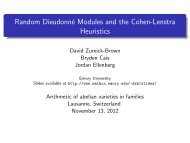alternative lecture notes - Rational points and algebraic cycles
alternative lecture notes - Rational points and algebraic cycles
alternative lecture notes - Rational points and algebraic cycles
You also want an ePaper? Increase the reach of your titles
YUMPU automatically turns print PDFs into web optimized ePapers that Google loves.
A functorial obstruction is given by specifying a subset X(A) obs between X(k) <strong>and</strong> X(A)<br />
for each X such that for any morphism f : X → Y , we have f(X(A) obs ) ⊆ Y (A) obs .<br />
Examples: X(A) Br , X(A) desc , X(A) fin , X(A) fin-Ab , X(A) conn , . . . .<br />
Suppose that we have f : Y → X a G-torsor over X, where G is a finite étale group.<br />
Given x 0 ∈ X(k), let c(x 0 ) be the class of f −1 (x 0 ) in H 1 (k, G). Then we can twist to obtain<br />
f c(x 0<br />
: Y c(x0) → X. We obtain<br />
X(k) =<br />
∐<br />
f σ (Y σ (k)) ⊆ ⋃ f σ (Y σ (A)) ⊆ X(A).<br />
σ∈H 1 (k,G)<br />
Define X f (A) := ⋃ f σ (Y σ (A)). Given an obstruction obs, define<br />
X f,obs (A) := ⋃ f σ (Y σ (A) obs ) ⊆ X(A) obs .<br />
For example, taking obs = Br gives the étale-Brauer obstruction set, which in our notation<br />
is X(A) fin,Br .<br />
X(A) fin <br />
X(A) fin-Ab <br />
X(A)<br />
X(k) <br />
X(A) fin,Br <br />
<br />
X(A) Br<br />
Let p: E → B be a fiber bundle with nonempty connected fiber F (the spaces are CWcomplexes,<br />
simplicial sets, or manifolds): i.e., B is covered by open sets U such that p −1 (U) ≃<br />
F × B over B. We can lift any point of B to a point of E. After lifting <strong>points</strong>, given a<br />
path in B connecting two <strong>points</strong>, we can lift it to a path between their lifts (first lift without<br />
worrying about the end of the path, <strong>and</strong> then modify a small piece of the end so that it ends<br />
where it should).<br />
We may assume that B is triangulated so that each simplex is contained in some U. Let<br />
be a solid triangle; then a section of F × → is a map → F . We are given the<br />
section above the boundary of the triangle; to fill in the lift, the obstruction lives in π 1 (F ).<br />
We get a 2-cochain in C 2 (B, π 1 (F )). But this is not exactly the obstruction to the existence<br />
of a section, because we could also change the choices made along the way.<br />
C 1 (B, π 1 (F )) → C 2 (B, π 1 (F )) d → C 3 (B, π 1 (F ))<br />
The kernel modulo image at the center is the definition of cohomology H 2 (B, π 1 (F )). In fact,<br />
the 2-cochain we constructed above lies in ker d. Also, changing the choice of lifts of paths<br />
corresponds to modifying it by an element of C 1 (B, π 1 (F )), <strong>and</strong> its differential measures the<br />
change in our 2-cochain. Thus we obtain a canonical obstruction lying in H 2 (B, π 1 (F )).<br />
After lifting the 2-skeleton, to lift the 3-skeleton, we obtain an obstruction in H 3 (B, π 2 (F )).<br />
Thus we get a sequence of obstructions, in H 2 (B, π 1 (F )), H 3 (B, π 2 (F )), H 4 (B, π 3 (F )),<br />
. . . , each one defined if the previous ones vanish (<strong>and</strong> one makes a choice).<br />
We would like to do the same for X → Spec Q, <strong>and</strong> even for arbitrary morphisms of<br />
schemes X → S.<br />
Let Sec(E → B) be the space of all sections, which is a topological space. We would<br />
like to compute the homotopy groups π ∗ Sec(E → B). These will be computed by a second<br />
3



